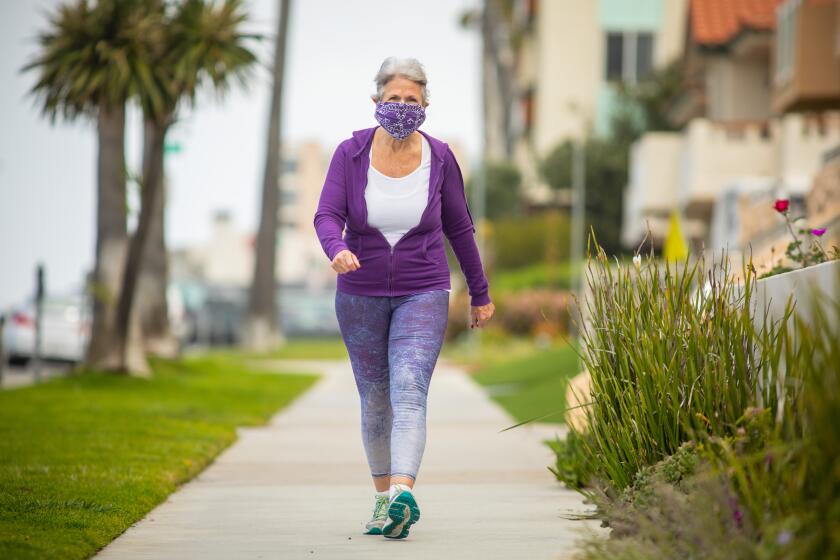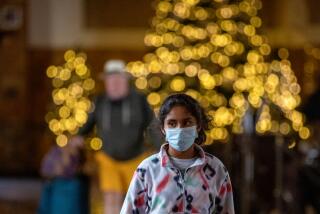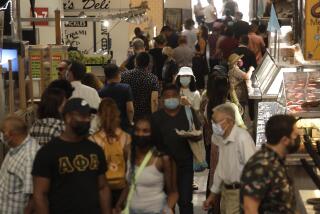Coronavirus could leave U.S. with a lasting imprint: Masks as normal part of life

- Share via
Amid the confusion from Washington, D.C., to Sacramento and parts in between, one thing has become abundantly clear in the era of COVID-19: The mask is having a moment.
On Thursday, President Trump announced that the Centers for Disease Control and Prevention would soon issue new guidelines, softening an earlier anti-mask stance. This came 33 days after the U.S. surgeon general tweeted that masks “are NOT effective in preventing general public from catching #Coronavirus.”
Gov. Gavin Newsom hewed to a similar path at a noon coronavirus briefing. He stopped short of telling Californians that they have to wear face coverings whenever they leave their homes, but he didn’t discourage use of the increasingly ubiquitous masks either.
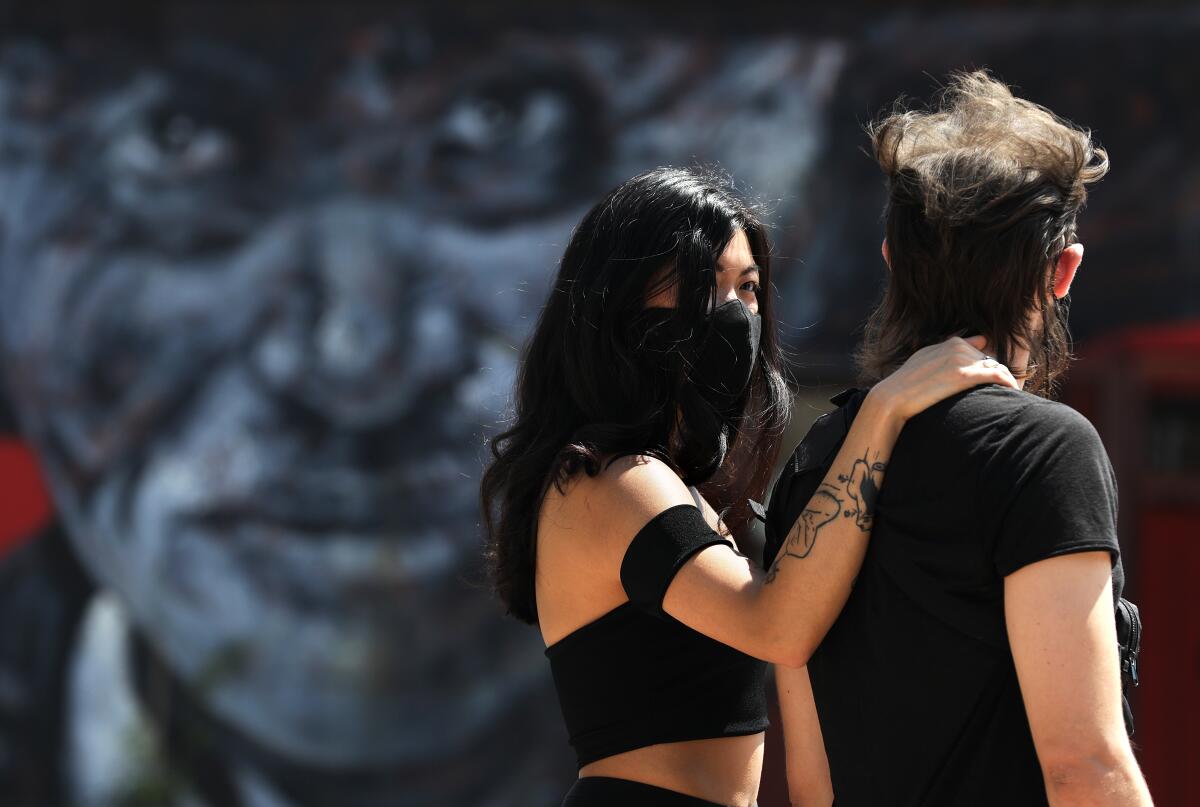
“We believe, and we put out guidelines, that if individuals want to have face coverings, that that is a good thing and a preferable thing,” Newsom said, “in addition to the physical distancing and the stay-at-home order.”
Once the protective head gear of choice for Asian immigrants and tourists, masks have popped up on shoppers at Walmart and Costco, on Justin Bieber and Selena Gomez, on the girl next door and maybe even your grandparents. BuzzFeed.com and the New York Times Style section have published celebrity selfie galleries. Masks are silencing sneezes from coast to coast.
The science is far from settled about the level of protection they provide. Still, concerned citizens are churning out DIY masks in retirement communities, suburban ranch houses and artist studios, using patterns found online or shared via email. They are giving their creations to friends and family members, donating them to first responders and helping fill an enormous protective equipment gap in the U.S. healthcare system.
And when the coronavirus finally departs our shores, the pandemic could leave behind a permanent reminder: the mask as an everyday accessory of American life.
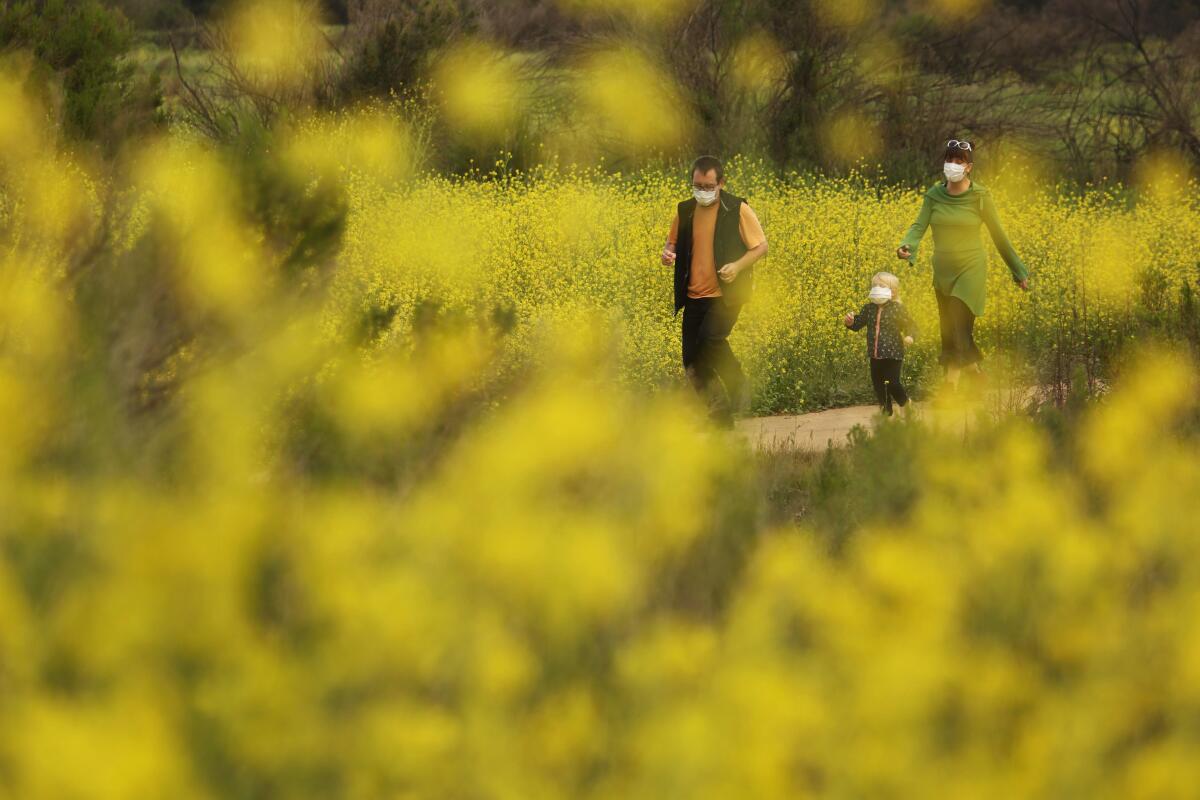
“We may be moving gently at this point toward the Asian culture where it’s more a usual thing to wear masks to prevent the transmission of viruses,” said Dr. William Schaffner, professor of preventive medicine and infectious diseases at Vanderbilt University. Even after the coronavirus crisis ends, “it wouldn’t surprise me if we don’t encourage this some in the near term.”
The problem, of course, is where to find them. The president may be encouraging the public to wear masks, but he hasn’t provided any shopping guides. They are a rare and precious commodity.
And that’s where Bibi Sheonarine comes in.
Three days before the first COVID-19 death was reported in California, the 66-year-old real estate broker decided to start making cloth masks from her Upland home.
First, she measured her face — ear to ear, nose to lower chin. Then she measured her husband’s face. He’s 73. She cut rectangles out of a bolt of cream-colored corduroy that she’d planned to use to make clothes for war-ravaged Syrians. She stitched elastic bands to the ends — and voila. The mask was done.
“It took me 10 minutes,” she said. “I made a simple video tutorial so others could make them, even a child.”
By March 27, she’d made 459 of them. Some went to local hospitals, others to family members in New York. And she realized that just maybe she and her neighbors could make a dent in the mask shortage. So she took to Facebook and Nextdoor, recruiting other crafty volunteers.
These are some of the unusual new scenes across the Southland during the coronavirus outbreak.
Nearly a week has passed, and more than 70 seamstresses in the Upland area have pitched in, cutting fabric or sewing. Sheonarine placed a bin filled with sewing kits on her porch; each contains instructions and enough fabric and elastic bands to make 25 masks. Eager mask-makers pick them up every day.
Sheonarine spends 20 hours or so each day on this potentially lifesaving project. She created a spreadsheet to organize the corps of volunteers, which grows in number every day. Recently a woman texted that her husband could cut the fabric for her with a laser, which would speed the process considerably.
“I was elated,” she said. “I wrote to her: ‘Laser, laser laser! Come over now!’”
The project has taken over Sheonarine’s house, in addition to her daily life. Her dining room is filled with rolls of yarn and fabric. An iron rests on the table. She figures she has about 1,000 yards of fabric at home, some printed with flowers, others with bears and stripes.
“I feel like a mini-Amazon,” she said. “Filling orders, picking up orders. But I feel good. People need them.”
Coronavirus: LAPD officers will wear face masks, coverings
Maybe they do. Maybe they don’t. It depends on who those people are, where they are, what kind of masks they plan to use and what they hope those masks will do.
Summer Johnson McGee, dean of the University of New Haven’s School of Health Sciences, said there is still a lack of research analyzing the effectiveness of using masks to slow the spread of the coronavirus. But she doesn’t see how wearing one can hurt.
“What do we have to lose?” she said. “Masks may prevent some transmission, which is better than not trying to prevent transmission at all.”
McGee said the initial reluctance among public health officials to push the general public to wear masks stemmed from wanting to make sure there were enough for healthcare workers, who are at the greatest risk of being infected by the virus.
But recent studies suggest that at least 12% to 20% of people who test positive for COVID-19 are asymptomatic and may be spreading the virus without realizing it.
Officials from San Francisco, San Mateo and Alameda counties said homemade masks and bandannas can help, while advising the public to leave medical-grade masks for healthcare workers.
“Given that we may not know who is carrying the virus and spreading it, we need to try to do whatever we can to prevent spread, including the use of cloth masks,” McGee said.
Chunhuei Chi, director of the Center for Global Health at Oregon State University, said government leaders who have called for people to don masks when leaving their homes may also have been influenced by the slow growth of coronavirus infections in East Asian places such as Taiwan, Japan, South Korea and Singapore, where wearing masks is common.
“They got their first cases much earlier than Europe and the U.S., but if you look at the total number of cases, they have been growing very slowly,” Chi said. “Wearing masks is one way that has allowed them to slow the number of cases.”
Chi said there is a lot of discussion among public health researchers as to why even homemade and surgical masks, which are not fine enough to filter out virus particles, are preventing the spread of the disease.
Masks can help protect a healthy person from getting infected by blocking droplets containing the virus from entering the mucus membranes in the mouth or nose. They can also prevent asymptomatic people from passing on the virus unknowingly.
“I highly recommend that people wear makeshift masks,” Chi said. “If you have a surgical mask, wear it, but even a cotton mask is very adequate for people to use.”
Health officials in the San Francisco Bay Area take that viewpoint to heart. On Thursday, the San Mateo County Joint Information Center recommended that residents of the region “cover their nose and mouth with cloth when leaving home for essential travel such as doctor appointments, grocery shopping or pharmacy visits.”
Still, Vanderbilt’s Schaffner has a rather large caveat. His wife found an old supply of masks they’d bought years ago during a previous viral epidemic. They’re sharing those with family members and using them when they go to the grocery store. If he didn’t have one, he said, he’d probably use a scarf.
“What’s the downside to asking people to put on masks or wrap their faces with a shawl?” he asked. “It may make some people think they’re bulletproof. Some bozo out there will say, ‘Let’s put on our bandannas and have a poker party tonight.’
“That’s what we call, in my family, ‘d-u-m dumb,’” he said.
Times staff writers Rong-Gong Lin II, Taryn Luna and David Lauter contributed to this report.
More to Read
Sign up for Essential California
The most important California stories and recommendations in your inbox every morning.
You may occasionally receive promotional content from the Los Angeles Times.


